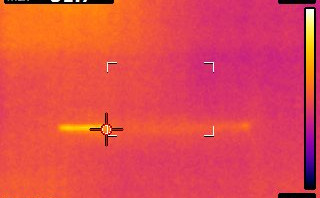Hi all!
Yesterday I ran a couple of experiments with the LEC. The results are somewhat preliminary (they should be repeated before taking them for granted), nevertheless they are quite interesting.
I activated a WE with my usual technique and tested its activity measuring the open circuit voltage. It was not so good as other times, but it still generated about 150 mV (about the half of my best devices). Moreover it showed an extremely fast tendency to oxidize, so its activity decreased rapidly (timescale of few hours). Even though I managed to carry out the planned experiments:
1) I imaged the WE in open air with a FLIR camera sensitive to mid IR (around 4-16 um), in order to detect any potential hotspot. The net result was that no hotspot or increased temperature were found. On the contrary, the active zone appeared cooler than surrounding environment. There may be a couple of conventional explanation to this: the active zone probably had residual humidity trapped, so the evaporation caused a slight decrease in temperature, or the emissivity of the plated zone was different than control zones (for example the hotter appearance of the non-active zone on the left is due to emissivity issues). So I don't think there is nothing really interesting, until this coolness is confirmed to be something "anomalous". Other thing to note: the camera resolution appeared a bit too low to observe very small hotspots (if any). These are a couple of shots from the WE before and after the activation (the background had a controlled emissivity close to 1):


2) I noticed (and this was not the first time actually) that the voltage measured on the LEC featured some small abrupt variations from time to time, so I decided to connect it to an audio interface to the PC, to record the signal at 44.1 kHz (22 kHz bandwidth). The audio interface was a good choice allowing to record for extensive time with an adequate frequency and amplitude resolution. The "pops" were clearly visible on the recording (timescale is seconds, amplitude is linear "mic" level, digitally amplified):

Also this result has to be confirmed, but it may be very interesting: these "pops" are very short in time (few ms) and sometimes happen in bursts. Apparently they have the characteristics of small "explosions". If this is true, this may be the way the ionization is generated: discrete energetic events that ejects "something" (accelerated particles o radiations) in the gas. Experimental notes: as a control, I connected a dummy LEC to the same audio input, in order to establish if this signal were noise/interference from outside. The dummy LEC didn't show these features. Interestingly enough, the use of an audio interface, with high impedance and very high sensitivity allowed to observe something that it is difficult to capture with an oscilloscope (thing that I've tried in the past, without meaningful results).
Another interesting observation: while the LEC output was spontaneously decaying due to oxidation, I observed some polarity reversal when changing the attached load or instrumentation. This imply that the work function difference is not the only source of voltage, there is probably some additional diffusion or space charge phenomena that can be temporarily reversed depending on the initial conditions.
Next experiment will be applying a PWM modulation to the plating current (same average current density as usual, but much higher peak current). Stay tuned! 
